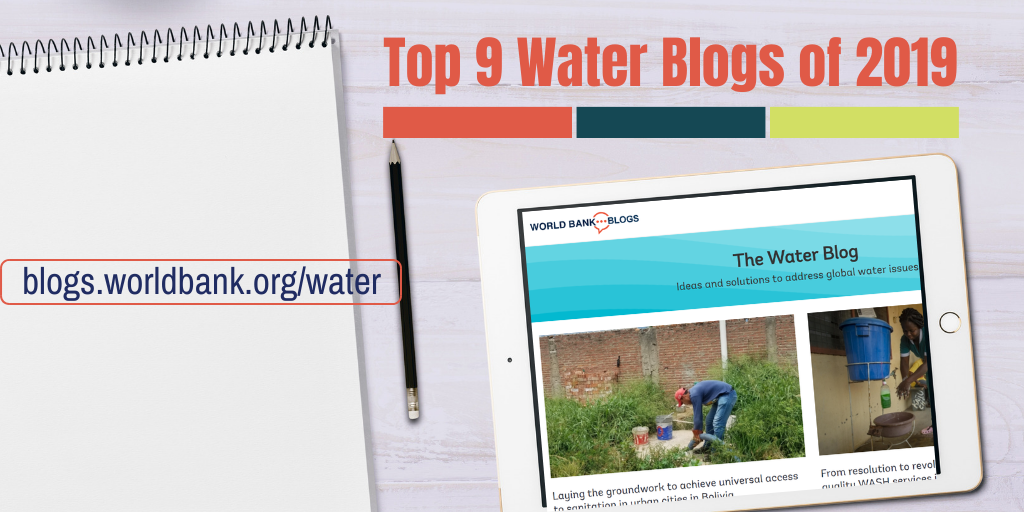 Top 9 water blogs of 2019
Top 9 water blogs of 2019
As we wrap up 2019, we continue our end-of-year tradition of recapping the top pieces from The Water Blog and creating this special list for you.
Here are our top nine blogs of 2019:
In Haiti, the poorest nation in the western hemisphere, almost 60% of the population live below the poverty line of $2.41 a day, and millions struggle to find clean drinking water. While the lack of clean water and sanitation had been a major problem in Haiti for years, the situation became dire in 2010 after a massive earthquake destroyed many of the existing sanitation systems. The water and sanitation sector, however, now has solid means to achieve progress. In this blog, Carl Christian Jacobsen, our Sr. Water Supply and Sanitation Specialist based in Haiti, reported progress made on the ground.
The recognition of water and sanitation as a human right has dramatically changed the way in which the WASH sector designs, plans, implements and monitors policies and programs aimed at increasing access to these basic services. A human rights-based approach to water and sanitation helps development agencies systematically consider the rural poor and vulnerable, and through that, increase the likelihood of quality WASH services for all. In this blog, our Senior Economist Christian Borja-Vega and guest blogger Eva Kloeve, Senior Program Officer in the Nordic Trust Fund Secretariat in the World Bank, took a deep dive into this approach.
The world of WSS utilities has changed dramatically since the mid-19th century, but this has not yet resulted in a big spur of innovation in the WSS sector. Practitioners often compare the water sector and the energy sector, as they share some similar characteristics. Yet, when looking at the number of patents filed and the volume of global investments in the energy and water sector, the water industry is lagging far behind. So why has innovation been so elusive in the WSS sector? In this blog, Caroline Van Den Berg debunks the myth.
To respond to the global water crisis, the World Bank Water Global Practice launched a new Strategic Action Plan earlier this year, which centers on three interrelated pillars: (1) sustain water resources, (2) deliver services, and (3) build resilience. These three pillars also formed the core themes of the Water GP's participation at this year's World Water Week (August 25-30, 2019). In this blog, Jennifer Sara, World Bank Global Director for Water, outlined how these critical areas contribute to the Sustainable Development Goals, and how our action plan will further strengthen our ability to help countries deliver on them.
Burgeoning informal settlements in cities make the provision of basic services especially difficult. Cities require sanitation approaches for such settings, which can complement, or precede the arrival of, traditional sewers and conventional on-site solutions. This thinking underpins the core principles of Citywide Inclusive Sanitation (CWIS) – encouraging cities to think about a diversity of technical solutions that provide services along the whole sanitation service chain, combining different approaches to better respond to the challenging realities faced by cities. Container-based sanitation (CBS) is one of the ways that such services can be provided. In this blog, the Bank’s CWIS team (including Clementine Marie Stip, Seema Thomas and Martin Gambrill) explains how CBS can help cities shift the focus from exclusively building sanitation infrastructure to that of service delivery.
Schools in rural Latin America often lack the sanitation facilities and supplies girls need for managing their periods. For instance, in rural areas of Peru, an astonishing 83 percent of schools had inadequate services or did not have any WSS services at all. To better understand the WSS gap in rural schools, the Bank’s water team in Peru joined forces with the Ministry of Education to develop the SIASE methodology (Sistema Integral de Agua y Saneamiento Escolar). In this blog, Malva Baskovich and Berenice Flores Arias Uijtewaal introduced SIASE as an organized and comprehensive system of WSS indicators in a school setting (both inside and surrounding the school premises) which helps identify the interventions that are necessary to provide a complete and quality service, at both local and national levels.
The upsurge of cholera cases in Yemen is attributed to several risk factors, including a disruption of basic water and sanitation services, contaminated water sources in affected communities, an inability to treat sewage due to non-functional wastewater treatment plants, and the absence of garbage collection systems. To ensure a comprehensive, appropriate and timely response to the country’s prevailing cholera outbreak, an integrated package of appropriate health, water and sanitation interventions has been designed and funded by the Bank through an IDA grant of $200 million. Despite all the challenges on the ground, key results have been achieved. In this blog, Naif Abu-Lohom, Dambudzo Muzenda, and Yogita Upadya Mumssen share experiences in supporting WASH interventions in a situation of ongoing conflict.
National governments and municipal authorities, with the support of development partners, are stepping up their efforts in ensuring everyone has access to “safely-managed” sanitation by 2030. Nonetheless, those collective efforts to improve the health and well-being of people around the world need to be mindful of a blind spot that remains in the sanitation service chain: the working conditions of sanitation workers. In this blog, Ndeye Awa Diagne and colleagues sharetakeaways from a workshop they co-organized with WaterAid, SNV, WHO, the International Labour Organization (ILO), the Water Research Commission of South Africa, at the fifth International Fecal Sludge Management Conference (FSM5) in Cape Town in Feb. 2019.
Gender divisions in water-fetching responsibilities have broader implications for social equality. In addition to reflecting deeply-rooted, gendered social roles, burdening women with the task of fetching water limits their use of spare time and restricts their ability to invest in gaining skills and education, and to engage in entrepreneurial activities which may improve their human-capital. It also raises the opportunity costs of working, lowers their reservation wages, and hampers women’s capacity to earn income and integrate into the labor market. The burden is even heavier for small girls, as loading the burden of fetching water onto them limits their ability to attend and finish school. In this blog, Christian Borja-Vega and Jonathan Grabinsky , focus the spotlight on the gendered dimension of water-fetching responsibilities in four countries across Latin America.
A big thank you to our bloggers who contributed big ideas and transformative solutions to the world’s most pressing water issues, to fulfill our vision for a water-secure world for all. And our sincere thanks also goes to YOU, our dear readers, for following along for another year.
Happy New Year and wishing you a successful and water-secure 2020!


Join the Conversation